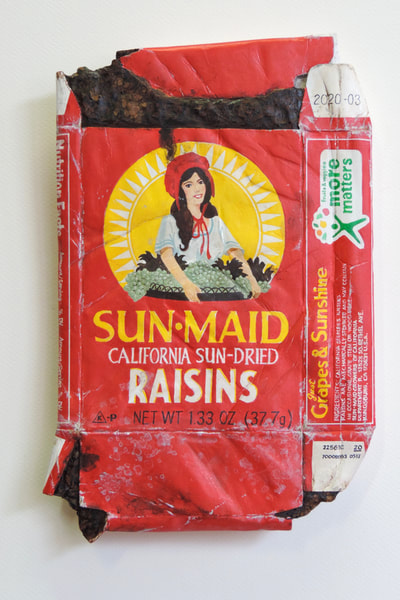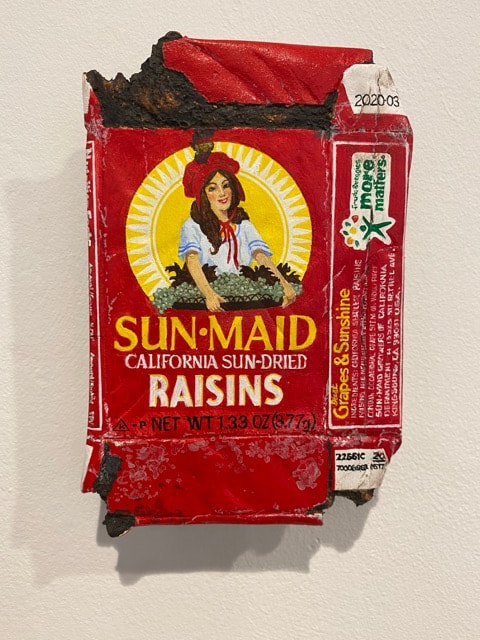Thomas Pfannerstill
Thomas Pfannerstill
Artist Statement
From The Street
The works in the series “From the Street” are carefully crafted, carved and painted, trompe l’oeil depictions of everyday common objects. On the back of each piece is a description of where and when I found this ‘gift from the street’ and so, they provide a record that mirrors my movements through time and space.
In the most obvious sense these pieces speak to issues of commercialism and consumerism. The objects reflect state-of-the-art-graphics; one can almost sense the well-planned and psychologically tested schemes to sell the products. They are a testament to the effectiveness of that marketing, after all, someone made the decision to purchase the product before consuming it and discarding the packaging. What happens next, though, is of greatest interest to me. These pieces are carried away and undergo a unique series of events that lead to their individuation.
Each of these objects was at one time a near-perfect clone of millions of others of it’s type. It was designed and manufactured to exacting standards. By the time I find it, it has become a tiny study of opposing forces. Mechanical geometric precision is altered by organic twists, bends and folds. The inherent rationality is overlaid with elements of chance. The sparkling clean surfaces are smudged and marked by everyday dirt, grit and grime. No two objects have exactly the same journey , so no two are marked in exactly the same way. Each wears a record of its own particular history, has become unique. It is this difference, this particular story of this particular object that I attempt to capture.
These works record harsh realities and the effects of exposure to natural elements over the course of time, time being a major consideration. The notation of where and when I found each piece reinforces this time element. There is also a missing time element, an implied narrative about how the object travelled from where it originated to where I happened upon it.These objects have a life span so to speak (if not an actual one, at least metaphoric one), from their production through their usefulness to their ultimate disposal. As such, I see them as ‘memento mori’, reminders of mortality and the corresponding corollary ‘carpe diem’. They are subtle reminders of the temporal nature of all things.
I choose my subjects for a wide variety of reasons, but often because of their sheer commonality. I like the fact that viewers know and recognize these images-- they are some of the most famous, heavily promoted brands. Even so, the packaging is constantly changing, companies are continually making subtle and sometimes not so subtle modifications. Altering layout and design, modernizing age-old characters and typefaces, adding graphics to reflect a temporary promotion or a movie or product tie-in, changing proportions and portion sizes (drink cups are the best example of that, growing to phenomenally large sizes, of late), using new materials like plastics and mylars-- all these changes keep the things on the street in a constant state of flux-- and provide an ever-changing array of new potential subject matter.
As time inevitably marches on and everything, trash included, continues to change, my little pieces ‘from the street’ will become increasingly ‘of a time.’ As the popularity of products ebb and flow and certain products disappear altogether as wants, needs and lifestyles change, they will become increasingly esoteric. They are handmade objects in a postindustrial culture, so already they are a bit anachronistic. They are markers of a time, though, and as such will become a tiny part of the fossil record, a small archeological artifact. They will be a small, hold-in your-hand object- a soild, 3-D reminder of the past-- an idea I find strangely comforting in a world that is increasingly electronic and virtual.
The works in the series “From the Street” are carefully crafted, carved and painted, trompe l’oeil depictions of everyday common objects. On the back of each piece is a description of where and when I found this ‘gift from the street’ and so, they provide a record that mirrors my movements through time and space.
In the most obvious sense these pieces speak to issues of commercialism and consumerism. The objects reflect state-of-the-art-graphics; one can almost sense the well-planned and psychologically tested schemes to sell the products. They are a testament to the effectiveness of that marketing, after all, someone made the decision to purchase the product before consuming it and discarding the packaging. What happens next, though, is of greatest interest to me. These pieces are carried away and undergo a unique series of events that lead to their individuation.
Each of these objects was at one time a near-perfect clone of millions of others of it’s type. It was designed and manufactured to exacting standards. By the time I find it, it has become a tiny study of opposing forces. Mechanical geometric precision is altered by organic twists, bends and folds. The inherent rationality is overlaid with elements of chance. The sparkling clean surfaces are smudged and marked by everyday dirt, grit and grime. No two objects have exactly the same journey , so no two are marked in exactly the same way. Each wears a record of its own particular history, has become unique. It is this difference, this particular story of this particular object that I attempt to capture.
These works record harsh realities and the effects of exposure to natural elements over the course of time, time being a major consideration. The notation of where and when I found each piece reinforces this time element. There is also a missing time element, an implied narrative about how the object travelled from where it originated to where I happened upon it.These objects have a life span so to speak (if not an actual one, at least metaphoric one), from their production through their usefulness to their ultimate disposal. As such, I see them as ‘memento mori’, reminders of mortality and the corresponding corollary ‘carpe diem’. They are subtle reminders of the temporal nature of all things.
I choose my subjects for a wide variety of reasons, but often because of their sheer commonality. I like the fact that viewers know and recognize these images-- they are some of the most famous, heavily promoted brands. Even so, the packaging is constantly changing, companies are continually making subtle and sometimes not so subtle modifications. Altering layout and design, modernizing age-old characters and typefaces, adding graphics to reflect a temporary promotion or a movie or product tie-in, changing proportions and portion sizes (drink cups are the best example of that, growing to phenomenally large sizes, of late), using new materials like plastics and mylars-- all these changes keep the things on the street in a constant state of flux-- and provide an ever-changing array of new potential subject matter.
As time inevitably marches on and everything, trash included, continues to change, my little pieces ‘from the street’ will become increasingly ‘of a time.’ As the popularity of products ebb and flow and certain products disappear altogether as wants, needs and lifestyles change, they will become increasingly esoteric. They are handmade objects in a postindustrial culture, so already they are a bit anachronistic. They are markers of a time, though, and as such will become a tiny part of the fossil record, a small archeological artifact. They will be a small, hold-in your-hand object- a soild, 3-D reminder of the past-- an idea I find strangely comforting in a world that is increasingly electronic and virtual.









